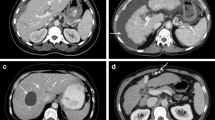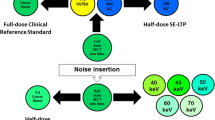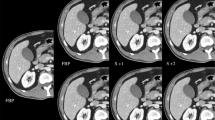Abstract
Objectives
To compare image quality and radiation dose of abdominal split-filter dual-energy CT (SF-DECT) combined with monoenergetic imaging to single-energy CT (SECT) with automatic tube voltage selection (ATVS).
Methods
Two-hundred single-source abdominal CT scans were performed as SECT with ATVS (n = 100) and SF-DECT (n = 100). SF-DECT scans were reconstructed and subdivided into composed images (SF-CI) and monoenergetic images at 55 keV (SF-MI). Objective and subjective image quality were compared among single-energy images (SEI), SF-CI and SF-MI. CNR and FOM were separately calculated for the liver (e.g. CNRliv) and the portal vein (CNRpv). Radiation dose was compared using size-specific dose estimate (SSDE). Results of the three groups were compared using non-parametric tests.
Results
Image noise of SF-CI was 18% lower compared to SEI and 48% lower compared to SF-MI (p < 0.001). Composed images yielded higher CNRliv over single-energy images (23.4 vs. 20.9; p < 0.001), whereas CNRpv was significantly lower (3.5 vs. 5.2; p < 0.001). Monoenergetic images overcame this inferiority in CNRpv and achieved similar results compared to single-energy images (5.1 vs. 5.2; p > 0.628). Subjective sharpness was equal between single-energy and monoenergetic images and diagnostic confidence was equal between single-energy and composed images. FOMliv was highest for SF-CI. FOMpv was equal for SEI and SF-MI (p = 0.78). SSDE was significant lower for SF-DECT compared to SECT (p < 0.022).
Conclusions
The combined use of split-filter dual-energy CT images provides comparable objective and subjective image quality at lower radiation dose compared to single-energy CT with ATVS.
Key points
• Split-filter dual-energy results in 18% lower noise compared to single-energy with ATVS.
• Split-filter dual-energy results in 11% lower SSDE compared to single-energy with ATVS.
• Spectral shaping of split-filter dual-energy leads to an increased dose-efficiency.


Similar content being viewed by others
Abbreviations
- ATVS:
-
Automatic Tube Voltage Selection
- CNR:
-
Contrast-to-noise Ratio
- FOM:
-
Figure of Merit
- SECT:
-
Single-energy CT
- SEI:
-
Single-energy Images
- SF-CI:
-
Split-filter Dual-energy Composed Images
- SF-DECT:
-
Split-filter Dual-energy CT
- SF-MI:
-
Split-filter Dual-energy Monoenergetic Images
- SSDE:
-
Size-specific Dose Estimate
References
Kaza RK, Caoili EM, Cohan RH, Platt JF (2011) Distinguishing enhancing from nonenhancing renal lesions with fast kilovoltage-switching dual-energy CT. AJR Am J Roentgenol 197:1375–1381
Hu R, Daftari Besheli L, Young J et al (2016) Dual-energy head CT enables accurate distinction of intraparenchymal hemorrhage from calcification in emergency department patients. Radiology 280:177–183
Metzger SC, Koehm M, Wichmann JL et al (2016) Dual-energy CT in patients with suspected gouty arthritis: effects on treatment regimen and clinical outcome. Acad Radiol 23:267–272
Diekhoff T, Kiefer T, Stroux A et al (2015) Detection and characterization of crystal suspensions using single-source dual-energy computed tomography: a phantom model of crystal arthropathies. Invest Radiol 50:255–260
Duan X, Li Z, Yu L et al (2015) Characterization of urinary stone composition by use of third-generation dual-source dual-energy CT with increased spectral separation. AJR Am J Roentgenol 205:1203–1207
Mangold S, De Cecco CN, Schoepf UJ et al (2016) A noise-optimized virtual monochromatic reconstruction algorithm improves stent visualization and diagnostic accuracy for detection of in-stent re-stenosis in lower extremity run-off CT angiography. Eur Radiol. https://doi.org/10.1007/s00330-016-4304-8
Ju Y, Liu A, Dong Y et al (2015) The value of nonenhanced single-source dual-energy CT for differentiating metastases from adenoma in adrenal glands. Acad Radiol 22:834–839
Uhrig M, Simons D, Kachelriess M, Pisana F, Kuchenbecker S, Schlemmer HP (2016) Advanced abdominal imaging with dual energy CT is feasible without increasing radiation dose. Cancer Imaging 16:15
Purysko AS, Primak AN, Baker ME et al (2014) Comparison of radiation dose and image quality from single-energy and dual-energy CT examinations in the same patients screened for hepatocellular carcinoma. Clin Radiol 69:e538–e544
Lee KH, Lee JM, Moon SK et al (2012) Attenuation-based automatic tube voltage selection and tube current modulation for dose reduction at contrast-enhanced liver CT. Radiology 265:437–447
Schindera ST, Winklehner A, Alkadhi H et al (2013) Effect of automatic tube voltage selection on image quality and radiation dose in abdominal CT angiography of various body sizes: a phantom study. Clin Radiol 68:e79–e86
Mayer C, Meyer M, Fink C et al (2014) Potential for radiation dose savings in abdominal and chest CT using automatic tube voltage selection in combination with automatic tube current modulation. AJR Am J Roentgenol 203:292–299
Lv P, Liu J, Zhang R, Jia Y, Gao J (2015) Combined use of automatic tube voltage selection and current modulation with iterative reconstruction for CT evaluation of small hypervascular hepatocellular carcinomas: effect on lesion conspicuity and image quality. Korean J Radiol 16:531–540
Euler A, Parakh A, Falkowski AL et al (2016) Initial results of a single-source dual-energy computed tomography technique using a split-filter: assessment of image quality, radiation dose, and accuracy of dual-energy applications in an in vitro and in vivo study. Invest Radiol 51:491–498
Marin D, Ramirez-Giraldo JC, Gupta S et al (2016) Effect of a noise-optimized second-generation monoenergetic algorithm on image noise and conspicuity of hypervascular liver tumors: an in vitro and in vivo study. AJR Am J Roentgenol 206:1222–1232
Schindera ST, Nelson RC, Mukundan S Jr et al (2008) Hypervascular liver tumors: low tube voltage, high tube current multi-detector row CT for enhanced detection–phantom study. Radiology 246:125–132
Vardhanabhuti V, Riordan RD, Mitchell GR, Hyde C, Roobottom CA (2014) Image comparative assessment using iterative reconstructions: clinical comparison of low-dose abdominal/pelvic computed tomography between adaptive statistical, model-based iterative reconstructions and traditional filtered back projection in 65 patients. Invest Radiol 49:209–216
Brink JA, Morin RL (2012) Size-specific dose estimation for CT: how should it be used and what does it mean? Radiology 265:666–668
Krauss B, Grant KL, Schmidt BT, Flohr TG (2015) The importance of spectral separation: an assessment of dual-energy spectral separation for quantitative ability and dose efficiency. Invest Radiol 50:114–118
Gordic S, Morsbach F, Schmidt B et al (2014) Ultralow-dose chest computed tomography for pulmonary nodule detection: first performance evaluation of single energy scanning with spectral shaping. Invest Radiol 49:465–473
Braun FM, Johnson TR, Sommer WH, Thierfelder KM, Meinel FG (2015) Chest CT using spectral filtration: radiation dose, image quality, and spectrum of clinical utility. Eur Radiol 25:1598–1606
Wuest W, May M, Saake M, Brand M, Uder M, Lell M (2016) Low-dose CT of the paranasal sinuses: minimizing x-ray exposure with spectral shaping. Eur Radiol. https://doi.org/10.1007/s00330-016-4263-0
Zhang LJ, Peng J, Wu SY et al (2010) Liver virtual non-enhanced CT with dual-source, dual-energy CT: a preliminary study. Eur Radiol 20:2257–2264
Guimaraes LS, Fletcher JG, Harmsen WS et al (2010) Appropriate patient selection at abdominal dual-energy CT using 80 kV: relationship between patient size, image noise, and image quality. Radiology 257:732–742
Chun M, Choi YH, Kim JH (2015) Automated measurement of CT noise in patient images with a novel structure coherence feature. Phys Med Biol 60:9107–9122
Funding
The authors state that this work has not received any funding.
Author information
Authors and Affiliations
Corresponding author
Ethics declarations
Guarantor
The scientific guarantor of this publication is Sebastian Schindera.
Conflict of interest
The authors of this manuscript declare relationships with the following companies:
Sebastian Schindera received a grant by Siemens Healthineers and a grant by Bayer Healthcare.
Daniele Marin received research support from Siemens Healthineers
Bernhard Krauss is an employee of Siemens Healthineers.
Statistics and biometry
Zsolt Szucs-Farkas kindly provided statistical advice for this manuscript.
One of the authors has significant statistical expertise.
No complex statistical methods were necessary for this paper.
Informed consent
Written informed consent was waived by the institutional review board.
Ethical approval
Institutional review board approval was obtained.
Methodology
• retrospective
• observational
• performed at one institution
Rights and permissions
About this article
Cite this article
Euler, A., Obmann, M.M., Szucs-Farkas, Z. et al. Comparison of image quality and radiation dose between split-filter dual-energy images and single-energy images in single-source abdominal CT. Eur Radiol 28, 3405–3412 (2018). https://doi.org/10.1007/s00330-018-5338-x
Received:
Revised:
Accepted:
Published:
Issue Date:
DOI: https://doi.org/10.1007/s00330-018-5338-x




